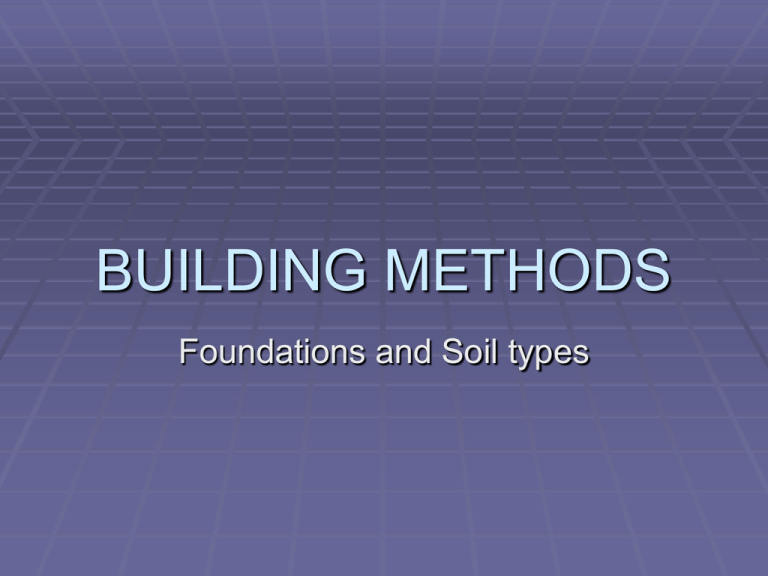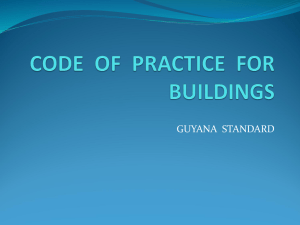Foundations powerpoint
advertisement

BUILDING METHODS Foundations and Soil types Main types of foundation Foundations or ‘footings’ come under two main categories: SHALLOW and DEEP Shallow foundations or ‘spread footings’ include pads, strip footings and rafts. Shallow foundations The guidelines for a shallow foundation are : They are founded near to the finished ground surface. The depth is generally less than the width of the footing and less than 3m. They are used when the surface soils are strong enough to support the load imposed upon it. Deep foundations Shallow foundations are unsuitable in weak or highly compressible soils. DEEP foundations include piles, pile walls and piers. Deep foundations are usually at depths deeper than 3m. Deep foundations are used to transmit the loading to a deeper, more competent strata Strip foundations These are use to support a line of loads such as a load bearing wall. They could also be used where the line of column positions are so close that individual pad foundations would be pointless. Raft Foundations These are used to spread the load from a structure over a large area. This would normally be the entire area of the structure. Raft foundations Raft foundations are often needed on soft or loose soils which have a low load bearing capacity. Pads and pile foundations Pad foundations support an individual point of load. Piles are used to support buildings in poor soil conditions. A basic pile foundation is a series of stilts which rest on a solid load bearing layer. SOIL TYPES The make up of the soil has a major influence on the choice of foundation. A good soil type needs to be able to cope with loadings. A good soil needs to drain water well. A poor soil type will shrink, swell or move depending on the loads or conditions placed upon it. SILT Silty soil is found in flood plains or around lakes. Silt holds water well and is soft when wet. Silty soil is not a very good foundation material unless it has been compressed and hardened, or has been dried out. SANDY SOIL Sand is usually considered favourable from the standpoint of foundation support. It can be a problem though usually due to water. Water raising through a sand deposit can create an unstable condition. Sandy soils can hold water. CLAY Clay is composed rock particles ground extremely fine or reduced by weathering. Clay soils normally contain water. Clay drains slowly and compresses when foundations are placed upon them. Clay has a tendency to absorb water and swell. GRAVEL Gravel can be well compacted and allows water to drain freely. Gravel soils do not hold water. The variety in particle sizes in gravel means that even when closely packed it still contains voids and drains well. Gravel is least likely to be affected by drying out. Forming foundations Profile boards. Profiles are used to set out foundations. These are established outside the limit of the of the excavation and always in pairs. These can be use as ‘sight rails’ with the aid of a ‘traveller’ to check on excavation depth. Profile boards Profile boards are used by the groundworker to establish foundation width. Bricklayers will use them when they start to lay the damp proof course of engineering bricks. Using profile boards. A number of nails are knocked into the top of the profile directly upon the relevant line to which it relates. The groundworker will use the centre line and the foundation limits to guide the line of the excavation along with the ‘traveller’ board to check the depth. Using profile boards. The bricklayers rely on the Building Line nails to guide their setting out. Lines will be set using the nails to indicate the face of the brickwork. From this line the position of the brickwork can be marked on the foundation using a spirit level off the line Engineering bricks Engineering bricks are used below ground and are strong and impervious to water. They are used where the strength of the brick and the need for a low level of water absorption is paramount. Engineering bricks Engineering bricks are not susceptible to frost. They are load bearing and have a high compression strength. They are used up to d.p.c where they will be exposed to wet and freezing conditions. They are used below ground because they are strong and impervious to water. They are usually used where appearance is not a factor. Engineering bricks form a barrier against the movement of moisture.











